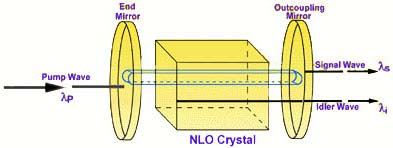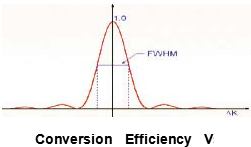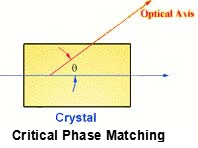Optical Parametric Generation (OPG):
ωp = ωs + ωi (or 1/λp = 1/λs + 1/λi in wavelength) It splits one high-energy photon into two low-energy photons. For example:
355 nm -> 532 nm + 1064 nm

Optical Parametric Generation (OPG) is an inverse process of Sum Frequency Generation. It splits one high-frequency photon (pumping wavelength, λp) into two low-frequency photons (signal, λs, and idler wavelength, λi). If two mirrors are added to form a cavity as shown in following Figure, an Optical Parametric Oscillator (OPO) is established. For a fixed pump wavelength, tilting a crystal can generate an infinite number of signal and idler wavelengths. Therefore, OPO is an excellent source for generating wide tunable
range coherent radiation. KTA, KTP, BBO, LBO and LiNbO3 etc. are proper crystals for OPO and Optical Parametric Amplifier (OPA) applications.

Phase-Matching
In order to obtain high conversion efficiency, the phase vectors of input beams and generated beams have to be matched:


∆K=k3-k2-k1=2p(n3/L3 -n2/ L2-n1/ L1)=0 (For sum frequency generation)
Where ∆K is phase mismatching, ki is phase vector at Li and ni is refractive index at Li.
In low power case, the relationship between conversion efficiency and phase
mismatching
is:h ∝ (sin (¤kL)/ ¤kL) 2
It is clear that the conversion efficiency will drop dramatically if ¤k increases.


The phase-matching can be obtained by angle tilting, temperature tuning or other methods. The angle tilting is mostly used to obtain phase matching as shown in the left figure. If the angle between optical axis and beam propagation (θ) isn't equal to 90°or 0°,we call it critical hase-matching (CPM).Otherwise, 90°non-critical phasematching(NCPM) is for θ = 90° and 0°NCPM is for θ = 0°.
Two types of phase-matching are classified according to the polarization of lasers. If the polarizations of two input beams (for sum frequency) are parallel to each other, it is called type I phase-matching. If the polarizations are perpendicular to each other, it is called type II phase-matching.

Conversion Efficiency
How to select a NLO crystal for a frequency conversion process with a certain laser? The most important thing is to obtain high conversion efficiency. The conversion efficiency has the following relationship with the effective nonlinear coefficient (deff), the crystal length (L), the input power density (P) and the phase mismatching (¤k):
∝ PL2(deff sin( ¤kL)/ ¤kL) 2
In general, higher power density, longer crystal length, larger nonlinear coefficients and smaller phase mismatching will result higher conversion efficiency. However, there is always some limitations coming from nonlinear crystals and lasers. For example, the deff is determined by the nonlinear crystal itself and the input power density has to be lower than the damage threshold of crystal. Therefore, it is important to select a right crystal for your applications. Table bellow we list out the laser and crystal parameters for selecting right crystals:





